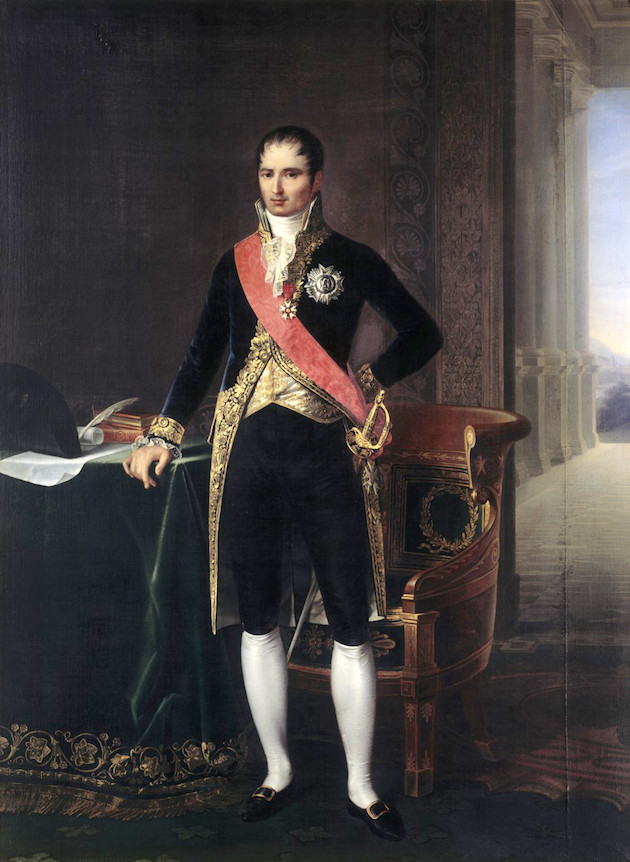Joseph Bonaparte was born on 7 January 1768 just over a year earlier than his brother Napoleon. He studied Law in Pisa in 1787 and began his career in Corsica, as a lawyer in Bastia, then as a judge at the Ajaccio Law court just as the French Revolution broke out. He took refuge with his mother and siblings in Marseille in 1793, where he married Julie Clary in 1794. Joseph Bonaparte was ambassador for the Directory first in Parma and then in Rome, and continued his diplomatic career during the Consulate, negotiating most notably the Treaty of Mortefontaine with the United States in 1800, the Peace of Lunéville with Austria and the Concordat with the Holy See in 1801 and the Peace of Amiens with England in 1802. Highlights of his military career were his appointments to the rank of colonel and Brigadier General in 1804, and as Major General and commander of the army of Naples in 1805. He was made King of Naples in March 1806, but gave up his throne in July 1808 to Joachim Murat to become King of Spain. The defeat of Vitoria, 21 June, 1813, marked the end of the Napoleonic presence in Spain. As Lieutenant General of the Emperor in 1814, he was not able to prevent the surrender of Paris on 30 March. Napoleon’s abdication in 1814 forced Joseph into exile in Switzerland, where he owned the Château de Prangins from 1814 to 1827. After the defeat of Waterloo, on 18 June 1815 and Napoleon’s second abdication, Joseph Bonaparte settled in the United States, later returning to live in Europe, in England from 1832 to 1837 and from 1841 in Italy, where he died in Florence on 28 July, 1844. Since the 1816 law forcing the Bonaparte family into exile was only repealed in 1848, Joseph Bonaparte never set foot in France again. His mortal remains were returned to France in 1862 where they joined those of his brother beneath the Dome of Les Invalides.
Robert Lefèvre, the official painter to the imperial family and high dignitaries of the Empire, did not date his portrait of Joseph and in the absence of documents, it is the analysis of the painting itself which allows a date to be ascertained (see Lang, Stoll, Becker , p. 14-16).
As a member of the Legislature and the Conseil d’État soon after Brumaire, French Prince and Grand Électeur of the Empire since 1804, Joseph Bonaparte is shown here wearing the official uniform of senator, a position he had held since August 1804. (Lang, Stoll, Becker, p. 14-16).
Paul Lang’s study of the decorations worn by Joseph, gives further information. As a member of the Grand Conseil de la Légion d’Honneur, Joseph is shown wearing the “Grande Décoration” of the Légion d’honneur whose badge was defined in 1804 (composed of a star with five double points, with white glaze, the centre of which bears the head of the Emperor surrounded by an oak branch and a laurel branch, attached to a red moiré ribbon worn on the lapel of his coat). An 1805 decree stipulated in addition the wearing of both a wide red ribbon stretching from the right shoulder to the left side at the bottom of which was attached a second large star that can be seen here beneath the hilt of the Senator’s sword (mandatory since 1803), and also a silver plate star decorated with five double points decorated in the centre by the Imperial eagle. The absence of a crown-shaped hook above the Cross, which had been decided in April 1806, confirms that the portrait must have been completed between January 1805 and April 1806. The analysis of the composition of the painting allows for more precise dating: in particular the presence on the table of a black bicorne hat rather than the official Senator’s hat which would have been adorned with white feathers. This bicorne, easily identifiable as that of the Emperor, marks the symbolic presence of the latter and, according to Paul Lang, refers to the regency that Joseph undertook on his brother’s behalf during the German campaign between August and December 1805. Paul Lang consolidates his stylistic interpretation noting the similarity of the posture of this man represented here in a position of power to those shown in the portraits of Napoleon, in 1802 by Jean-Antoine Gros, and in 1804 by Jean-Auguste-Dominique Ingres.
The colonnade and landscape elements in the background (greenery, building) are symbolique and are not caracteristic of an identifiable place in which Joseph Bonaparte stands.
This portrait, which from 1878 had been in the possession of the family of Marshal Niel, Napoleon III’s War Minister, was acquired by the Swiss National Museum, for the Château de Prangins in 1995.
Irène Delage, August 2016 (translation, R. Young)
Main sources:
– Joseph Bonaparte et le château de Prangins. Deux acquisitions du Musée national suisse, Paul Lang, Anna Stoll, Thomas Becker, Institut suisse pour l’étude de l’art, Zurich, 1997, 54 p.
– Joseph Bonaparte, Thierry Lentz, éditions Perrin, Paris, 2016, 752 p.
This portrait is published in our Paintings Section with the gracious permission of the Swiss National Museum to whom we extend our grateful thanks.


